B.V. Lawson's Blog: In Reference to Murder, page 248
April 23, 2012
Media Murder for Monday
 MOVIES
MOVIES
This bit of casting is probably going to be as controversial and hotly debated as the news that 5'9" Tom Cruise would play 6'6" Jack Reacher from Lee Child's novels. It appears the film adapation/reboot of the popular 1970s TV show Rockford Files (originally starring James Garner), is being filmed as a star vehicle for Vince Vaughn. (Hat tip to Omnimystery News.)
Ben Affleck and Justin Timberlake are teaming up in Runner, Runner, a thriller about online gambling. Brad Furman, the same director behind the film adaption of Michael Connelly's novel The Lincoln Lawyer, is also on board the project.
Taken director Pierre Morel has signed on to direct Bastille Day, an action thriller about a young American artist living in Paris who teams up with a washed-up CIA agent to prevent an attack on the city.
Christian Bale and Bradley Cooper may be teaming up for a film written by Eric Singer about the 70s FBI sting operation Abscam that took down a bunch of U.S. congressmen. It's not a done deal, but it has a director (David O Russell) and funding appears to be in place.
Hat to Janet Rudolph of Mystery Fanfare for alerting us to upcoming noir film events at the San Francisco International Film Festival and Arthur Lyons Film Festival in in Palm Springs.
Speaking of film festivals, the Noir City Festival in Los Angeles will also be screening 30 rarely-seen films through May 6th at Hollywood's Egyptian Theatre.
TV
The eight-part series The Great American Manhunt began on NatGeo TV this past Friday (but hopefully you can catch the first installment On Demand). It's a reality challenge show sets that pits three real-world crime experts (a cop, a forensic scientist and a forensic psychologist) against each other in hunting down a real-life mystery target at large without any modern shortcuts like DNA, dental records or ID databases.
USA has announced the summer return dates for Burn Notice, White Collar, Covert Affair and more.
The Canadian Broadcasting Corp. is adding a new crime drama, Cracked, to its 2012-13 schedule. The police procedural stars Stefanie von Pfetten (Battlestar Galactica). The CBC had earlier announced it had acquired Murdoch Mysteries, a period drama from Shaftesbury Films.
Mariska Hargitay has signed a deal with Law & Order: Special Victims Unit to return for a 14th season next year.
The producers of Homeland announced new characters and storylines for the second season debuting in September. There's also a trailer on this link (with a warning for possible spoilers).
The original Netflix mob drama Lilyhammer is returning for a second season. The show folows Frank 'The Fixer' Tagliano (played by Steven Van Zandt) as he attempts to start a new life in Lillehammer, Norway.
Actor Vince Vaughn is developing a new drama about global private security operatives with Boardwalk Empire's Lawrence Konner. I have a feeling this project will be a little less controversial for Vaughn.
PODCASTS/RADIO
David Suchet, who plays the perfect Hercule Poirot in the BBC's television adaptations of Agatha Christie's series, talked with BBC Radio 4 about his role in a new production of Long Day's Journey Into Night and the upcoming final installments of the Poirot series.
Sarah Weinman discusses the new book Hit Lit, by mystery writer James W. Hall, and his case that the biggest hits from the past hundred years share 12 features.
THEATER
Academy Award-nominated playwright Jose Rivera will join the production of his Off-Broadway drama Massacre (Sing to Your Children) for the April 23 and 25 performances—as an actor. The psychological drama is set in a small New Hampshire town where seven friends conspire to murder their mysterious neighbor Joe.
Author Anthony Horowitz, the creator of the TV series Foyle's War, is also a successful playwright, and his psychological thriler Mindgame (that debuted off-Broadway in 2008), is being staged in several locations: by the Progress Theatre Company in the UK in May; the Willits Community Theatre in Northern California; and the UK's Loft Theatre in September.





April 22, 2012
World Book Night

The first World Book Night was held in the UK in 2011, and its success has spawned a U.S. effort and similar events in other countries. Tomorrow (Monday, April 23) is the very first World Book Night in the U.S., when tens of thousands of volunteers across the country will hand out free copies of books in their communities. Publishers, bookstores, libraries and authors are also donating their services and time. The goal is to give books to new readers, encourage reading and just share a passion for terrific books. Or, as the WBN website says, "The goal of World Book Night is to seek out reluctant adult readers wherever they are, in towns and cities, in public settings or in places from nursing homes to food pantries, low income schools to mass transit."
Although it's too late to volunteer for this year's event, organizers hope it will become an annual tradition. Check out the 30 books on this year's list, and maybe you have a copy of one of the titles you can pass along to a reluctant reader among your friends, family and colleagues.





April 21, 2012
Booksellers and Librarians Solve Mysteries
For a listing of member participants, check out the SinC blog , which also has more details about where folks will be adding reports and information as the day progresses. In addition, SinC's more than 3,000 members are supporting the "Solving Mysteries Day" event by going into libraries and bookstores today to personally thank the booksellers and librarians they find working behind the counters and in the stacks. You don't have to be a member of SinC to do this - it you have some spare time today, head to your local bookstore and/or library and let the staff know how much you appreciate them.





Friday's "Forgotten" Book - More Good Old Stuff
Patti Abbott has been experimenting with a one-author feature for Friday's "Forgotten" Books, such as the recent Donald E. Westlake day. This time, she conducted a poll to see which author people were most interested in featuring and John D. MacDonald (1916-1986) came up the winner.
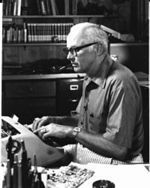 MacDonald, author of over 70 novels, is best remembered for the books featuring Florida-based private eye Travis McGee, who the Washington Post's Jonathan Yardley called "one of the great characters in contemporary American fiction -- not crime fiction; fiction, period." MacDonald himself admitted he enjoyed the detective genre because it gave him a captive audience for his favorite parts of the books, the asides. He said, "I can have the hero hanging on a ledge with somebody pounding on his knuckles with a hammer, and I can go off and make a comment on something in the world that's bugging me, and when I come back, the readers will still be there."
MacDonald, author of over 70 novels, is best remembered for the books featuring Florida-based private eye Travis McGee, who the Washington Post's Jonathan Yardley called "one of the great characters in contemporary American fiction -- not crime fiction; fiction, period." MacDonald himself admitted he enjoyed the detective genre because it gave him a captive audience for his favorite parts of the books, the asides. He said, "I can have the hero hanging on a ledge with somebody pounding on his knuckles with a hammer, and I can go off and make a comment on something in the world that's bugging me, and when I come back, the readers will still be there."
The prolific author actually got his start writing short stories. While he was in the Army in 1945, he sent a short story home to his wife, who promptly typed it up and submitted it to Story magazine. The editors bought it for $25, thus giving MacDonald the idea that he could make a career as a writer. He told Ed Gorman in an interview that after leaving the Army, "I wrote eight hundred thousand words of short stories in those four months, tried to keep thirty of them in the mail at all times, slept about six hours a night and lost twenty pounds."
He eventually sold over six hundred stories to a variety of magazines in a variety of genres, from mystery to sports, to sci-fi, to westerns, to romances. Some of the publications his stories appeared in included crime pulps like Dime Detective and Black Mask, but he was also published in higher-profile glossy 'zines like Esquire, Playboy and Cosmopolitan. His stories were also included in various anthologies and in collections including:
End of the Tiger and Other Stories (1966)
S*E*V*E*N (1971)
Other Times, Other Worlds (1978)
The Good Old Stuff (1982)
More Good Old Stuff (1984)
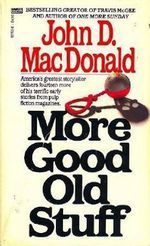 The 1984 collection, More Good Old Stuff, contains 14 of MacDonald's earlier stories from the pulp mystery/detective magazines of the late 1940s. They include "Deadly Damsel," the story of a professional widow (who has wed and murdered five husbands) and an amateur con man who get fatally tangled in a web of their own devising, from which we get lines like these:
The 1984 collection, More Good Old Stuff, contains 14 of MacDonald's earlier stories from the pulp mystery/detective magazines of the late 1940s. They include "Deadly Damsel," the story of a professional widow (who has wed and murdered five husbands) and an amateur con man who get fatally tangled in a web of their own devising, from which we get lines like these:
"Death gave her a feeling of power that she bore with her wherever she went. She looked at the dull, tidy little lives of the women in the small cities in which she lived, and she felt like a goddess. She could write all manner of things on the black slate of life, and then, with one gesture, wipe the slate clean and begin all over again. New words, new love, new tenderness and a new manner of death... It was good to kill men..."
Or there's "Death for Sale," about a hired killer with a broken soul who stalks a French Nazi-collaborator to a New Orleans restaurant, where hunter and quarry suddenly trade places. MacDonald wrote in the Foreword that he was "tempted to clean up some of the very stilted dialogue" and change the gimmick at the end of this story, but it would "be unfair to excise the warts to make myself look better than I was."
MacDonald was almost apologetic in his Foreword about how dated some of the stories were (he updated some minor details because of that), but as he also said, "The events of these stories are in a past so recent they could just as well have been written today. And that is a portion of my intent, to show how little the world really changes." Those words could almost serve as a summary of these early stories; although they lack the polish and the more intense, well constructed plots that were to come, the nugget of great storytelling that marks the author's work is all there and changed very little over time, but just got better.





April 20, 2012
Friday's "Forgotten" Books - The Killings at Badger's Drift
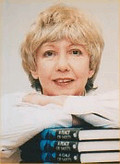 Caroline Graham (born in the UK in 1931) had what you would definitely call a varied background, including leaving school at age 14 to work in a factory, a stint in the Navy, professional dancer, actress, journalist and scriptwriter for radio plays followed by television work. But her desire to write novels led her to publish the romance novel Fire Dance in 1982 when she was in her 50s, followed by several other books that had modest success.
Caroline Graham (born in the UK in 1931) had what you would definitely call a varied background, including leaving school at age 14 to work in a factory, a stint in the Navy, professional dancer, actress, journalist and scriptwriter for radio plays followed by television work. But her desire to write novels led her to publish the romance novel Fire Dance in 1982 when she was in her 50s, followed by several other books that had modest success.
In 1987 she published her first crime fiction novel, The Killings at Badger's Drift, which introduced DCI Tom Barnaby and Sergeant Gavin Troy and won the Macavity Award for "Best First Novel" (in addition to being nominated for the same honor by the Anthony and Agatha Awards). In 1990, the Crime Writers' Association selected Badger's Drift as one of the top hundred crime novels of all time.
The DCI Barnaby series was popular enough to spawn six more installments, but it wasn't until ITV came calling that the fortunes of Graham (and Barnaby) really took off. The televised series Midsomer Murders, based on Graham's books and starring John Nettles, began with an adaptation of Badger's Drift in 1997 and is still going strong with new episodes 15 years later. Graham herself has written many of those episodes, but several other writers have also contributed, including Anthony Horowitz (the creator of Foyle's War, among many other works). Graham's ultimate success prompted her to achieve another dream, an advanced degree in Writing for the Theatre at Birmingham University that she obtained at the age of 60.
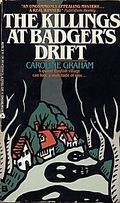 The Killings at Badger's Drift is set in an idyllic English village of that name filled with stereotypical characters including vicar, bumbling local doctor, and kindly spinster who taught almost everyone in town. When the spinster dies, everyone believes it was natural causes—except for her closest friend, Miss Lucy Bellringer, who is convincing enough that Chief Inspector Barnaby orders an autopsy. When the coroner finds the woman died of hemlock-laden wine, Barnaby and Sargeant Troy begin to peel away layers of scandals and festering resentments in the town that provides them with plenty of suspects. And then, the murderer strikes again, leaving a woman's bloody corpse to be found by her son, the local undertaker...
The Killings at Badger's Drift is set in an idyllic English village of that name filled with stereotypical characters including vicar, bumbling local doctor, and kindly spinster who taught almost everyone in town. When the spinster dies, everyone believes it was natural causes—except for her closest friend, Miss Lucy Bellringer, who is convincing enough that Chief Inspector Barnaby orders an autopsy. When the coroner finds the woman died of hemlock-laden wine, Barnaby and Sargeant Troy begin to peel away layers of scandals and festering resentments in the town that provides them with plenty of suspects. And then, the murderer strikes again, leaving a woman's bloody corpse to be found by her son, the local undertaker...
Caroline Graham manages to channel the Golden Age mysteries and preserve the same small-town English village milieu popularized by Agatha Christie, while throwing in modern touches and a little more violence and sex. Chief Inspector Barnaby and Sergeant Troy are polar opposites and both well-drawn—Barnaby the conservative, thoughtful, married officer with a dry wit, and Troy, the young, handsome, know-it-all. Publishers Weekly said that "Graham makes the characters humanly believable in her witty and tragic novel, a real winner," while the Washington Post noted "The characters are strong, with a decidedly dark side, and the plot is twisted enough to stump the most astute."
The settings and descriptions are also detailed, astute and quite fun to read, as in this excerpt:
She was very, very fat. She spread outwards and towered upwards. At least a quarter of her height seemed to be accounted for by her hair, which was a rigid pagoda-like structure: a landscape of peaks and waves, whorls and curls ending in a sharp point like an inverted ice-cream cone. It was the colour of butterscotch instant whip. She wore a great deal of makeup in excitable colours and a lilac caftan, rather short, revealing bolstery legs and tiny feet. The chief inspector fielded her welcoming glance, direct and sharp as a lancet, and introduced himself.
This is a wonderful introduction to Graham, to Barnaby and even to the TV program, although those episodes have veered away from the original material a bit. It's a pity there were only seven books in the series.





April 19, 2012
Mystery Melange
Melville International Crime has just released Dead Man Upright, thus restoring all five of Derek Raymond's "Factory Novels" to print for the first time in nearly a decade. Melville calls the series books "among the grimmest and yet most heartfelt works of noir ever composed. Brooding and metaphysical in their purpose, Raymond's novels are both innovative works of style and searing indictments of the inherent violence of bureaucracy." For a clip of the author reading from his novel He Died with His Eyes Open, click here.
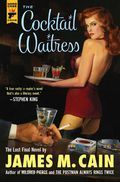 This September, Hard Case Crime will release James M. Cain's final unpublished crime novel, titled The Cocktail Waitress, and is teasing fans with the new cover for the book. You can also find an excerpt of the first chapter via that same link. Stephen King adds ""Here, long after anyone would have expected it, is the voice of James M. Cain, as fresh and as relevant as ever. The Cocktail Waitress will involve you, and then shock you with an ending you’ll never forget. This is a true rarity: a reader’s novel that’s also a literary event."
This September, Hard Case Crime will release James M. Cain's final unpublished crime novel, titled The Cocktail Waitress, and is teasing fans with the new cover for the book. You can also find an excerpt of the first chapter via that same link. Stephen King adds ""Here, long after anyone would have expected it, is the voice of James M. Cain, as fresh and as relevant as ever. The Cocktail Waitress will involve you, and then shock you with an ending you’ll never forget. This is a true rarity: a reader’s novel that’s also a literary event."
The Washington Post takes a hard look at flawed FBI forensics processes and how the Department of Justice's promises to protect the rights of defendants became more of an exercise in damage control, leaving prisoners locked away or in the dark for years longer than necessary.
Mystery Fanfare has the winners of this year's Romantic Times Reviewer's Choice Awards in the crime fiction categories that include Contemporary Mystery, Historical Mystery, First Mystery, Amateur Sleuth and Suspense/Thriller. Congrats to all!





April 17, 2012
At the (London Book) Fair

The venerable and gigantic London Book Fair started this week, with hundreds of international vendors of all stripes from the publishing world. It's also well known for bringing together film and TV producers with over 400 literary agencies and publishers offering content with screen adaptation potential. Here are some of the highlights thus far from the blogosphere:
Ayo Onatade is blogging about the event for Shots Magazine online and has some of the book and TV deals that have already been inked (more to come!).
Barnes & Noble is recruiting publishers for new content to show up in the Nook Store in the US, including British and global authors and books.
Josh Getzler is reporting on the LBF for the blog Hey, There's a Dead Guy in the Living Room, including the fair's international flare and how the "people have been simply wonderful--smart, productive, all excited to talk books."
OverDrive reported on recent library ebook usage data, noting that during the month of March, OverDrive recorded a total of over 12.6 million visits from 219 different countries; 86% of those visitors came from the US, with another 10% coming from Canada with UK, NZ, and Australia rounding out the top 5.
International Publishers Association also talked about digital publishing at the "Global Publishing Statistics" seminar. Digital migration has taken off in the UK and US, but not in other countries, and small and medium-sized publishers were encouraged to look to foreign markets to increase the bottom line. One possible bright note: in China, reading and writing online is an enormous industry, with very successful authors started online which have then migrated into the printing world."
Speaking of China, the LBF opened with a protest against a special section dedicated to China, thanks to the Chinese government's censorship policies that have led to the imprisonment of authors and also the LBF's decision to invite only an officially sanctioned slate of Chinese writers.
For a listing of all the crime fiction publishers/exhibitors, check out the listing here.





Top 10 Criminal Justice Zines
The General Blog of Crime (run by a "gang" of criminologists), noted that Google Scholar publishes journal rankings using an algorithm Google developed that takes into account the number of articles and cross-references in the past five years. The list of top criminology journals looked something like this (a little over 10, due to ties):
1. Criminal Justice and Behavior
2. Criminology
3. Journal of Interpersonal Violence
4. Violence Against Women
5. tie British Journal of Criminology
5. tie Trauma, Violence, & Abuse
6. Criminology & Public Policy
7. tie Journal of Family Violence
7. tie Journal of Research in Crime and Delinquency
8. tie Crime & Delinquency
8. tie Intl Journal of Offender Therapy and Comparative Criminology
8. tie Journal of Criminal Justice
8. Violence and Victims
As the author (Christina DeJong, Assoc. Prof at Michigan State) of the blog post notes, you get a different ranking when you include an impact factor for the same journals. At any rate, if you're not familiar with these publications, it's a great resource link. So is Google Scholar, by the way; professional search results with any references to Snooki or the Kardashians.





April 15, 2012
Media Murder for Monday
 MOVIES
MOVIES
Warner Bros bought the rights to the new Dennis Lehane novel coming out this fall, Live By Night, as a star vehicle for Leonardo DiCaprio. The novel uses characters from Lehane's earlier novel The Given Day and brings them into the Prohibition era.
Warner Bros has also snapped up the screen rights to a debut thriller by Roger Hobbs titled The Ghostman, which also won't be published until later this year The book centers a young man who cleans up messes and helps fugitives disappear, but ends up involved in a casino heist gone terribly wrong. The seven-figure deal has the studio taking a chance on a script they haven't yet seen, but Warner Brothers is apparently eager to proceed with the project because "it has franchise potential for a young leading man in his 30s."
Joseph Finder's novel Paranoia, a corporate espionage thriller set in the world of dueling telecom giants, is being adapted for film. The project has signed Robert Luketic to direct and The Hunger Games' Liam Hemsworth to play the lead. Also in talks to join the cast are veteran actors Harrison Ford and Gary Oldman.
Mark Whalberg is in early talks to play Patrick Lanigan in the film adaptation of John Grisham’s eighth legal thriller The Partner. The character of Lanigan is a young partner in a prominent law firm who fakes his own death to steal a fortune from his company and set up a new life in Brazil.
Woody Harrelson and Forest Whitaker have joined the cast of Out Of The Furnace. The film follows two brothers(played by Christian Bale and Casey Affleck), who find themselves gradually sucked into a life of crime. Harrelson will play a crime boss and Whitaker town sheriff Wesley Barnes.
TV
Woody Harrelson is a busy man. He and Matthew McConaughey will star in an eight-part cable cop drama titled True Detective, described as an elevated serial narrative with multiple perspectives and time frames.
HBO has acquired rights to Philip Kerr's novel Berlin Noir to adapt into a television series following police officer Bernie Gunther in 1930s Germany, set during the run-up to WWII and then the Cold War following.
The British miniseries Spies of Warsaw, based on Alan Furst's novel, will be co-produced by BBC America, meaning the series will appear on that network in the U.S. as part of its Dramaville programming block. The series stars David Tennant (Doctor Who) and Janet Montgomery (Black Swan) and is set in Poland, Paris, London and Berlin in the years leading up to the Second World War.
AMC is developing a television adaptation of the new crime comic series Thief of Thieves, written by Robert Kirkman and Nick Spencer. The plot centers on Conrad Paulson, who lives a secret double life as master thief Redmond. (Hat tip to Omnimystery News.)
As Omnimystery News also reports, Stephen Fry and Dougie Henshall have signed to star in Doors Open, a TV adaptation for ITV in the UK of the 2008 stand-alone heist novel by Ian Rankin.
The BBC's two-parter starring Martin Shaw, that's loosely based on the George Gently books by British author Alan Hunter, is starting to show up on various PBS stations around the country. (Check with your local station for possible scheduling.)
Craig McLachlan has been cast as the lead in a new Australian Broadcasting Company period crime drama. Titled The Dr. Blake Mysteries, the ten-part series features McLachlan playing Dr. Lucien Blake, GP and police surgeon in 1959 Australia.
PODCASTS/RADIO
Philip Kerr joined host Linda Wertheimer on NPR's Weekend Edition Saturday to talk about his latest novel featuring World War II-era cop Bernie Gunther and how Kerr created Bernie as a sort of German Everyman, who confronts the moral quandaries of his time. (See HBO news item above for more on Bernie's exploits.)
THEATER
In June, the Halifax County Little Theatre in South Boston, Virginia, will present free stagings in Constitution Square of the play Velda: Girl Detective, by author/illustrator Ron Miller (who worked as a production illustrator for the motion picture version of Dune). Velda is based on a character Miller created for a novel and series of short stories and comic books.





April 12, 2012
The 'Zine Scene
The April issue of Suspense Magazine is out, with a list of the 3rd annual short story contest winners. Harlan Coben also has an exclusive interview, along with Marilyn Levinson. There are excerpts of the latest books from D.P. Lyle and Brett Battles, and much more. FYI to authors: the 'zine is opening up their online radio station and will play audio clips of your books, gratis. Email editor@suspensemagazine.com for the details.
The spring edition of Pulp Metal Magazine online is also live, with Paul D. Brazill's column on Detective Sergeant George Bulman (based on the books by Kenneth Royce) and his appearances in various British TV series; writer interviews including Jodi MacArthur talking to Yelena Sabel, Jason Michel chatting with Mr Glamour, and Richard Godwin and Katy O'Dowd speaking to Jason Michel; plus short stories and more.
Issue #45 of Crimespree Magazine has a cover story with Hilary Davidson, interviewed by Ruth Jordan and Jen Forbus. Gary Shulze also talks about the annual Write of Spring event at Once Upon A Crime in Minneapolis; Joe Finder is interviewed by Judy Bobalik; and there are stories, columns, and fun galore. Check out the index here.
You can still order a copy of Mystery Readers Journal and its Winter/Spring issue dedicated to"Shrinks and Other Mental Health Professionals in Mysteries."
As I mentioned earlier, the latest (and first in one case) issues of Needle and Grift are also available for your reading pleasure.
I'm a tad late, but the Winter/Spring Plots with Guns issue is available (with stories by Eric Bandel, Taylor Brown, Terry Butler, Andy Henion, Erik Lundy, Dan Ray, Craig Renfroe, Nick Ripatrazone, and Tim L. Williams), as is the latest Mysterical-E issue, packed with its usual story goodness.
And don't forget to vote for the 2012 Spinetinger Magazine awards.





In Reference to Murder
- B.V. Lawson's profile
- 201 followers



